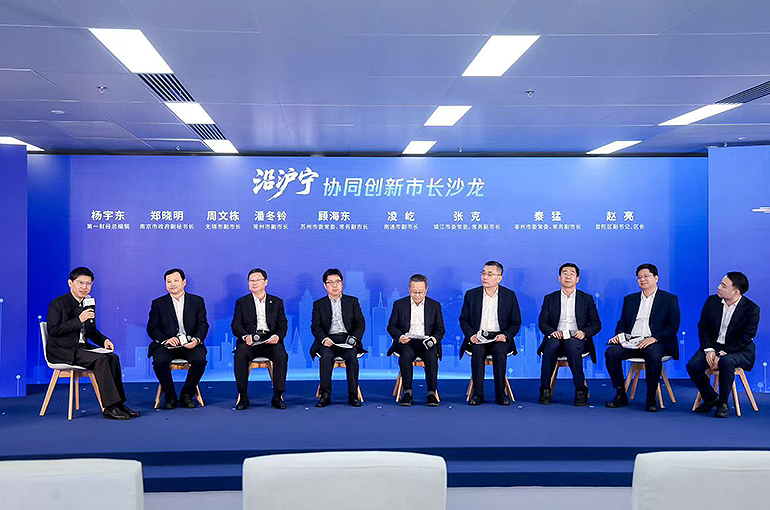 Shanghai-Nanjing Belt City Leaders Meet to Discuss Collaborative Innovation Agenda
Shanghai-Nanjing Belt City Leaders Meet to Discuss Collaborative Innovation Agenda(Yicai) Oct. 30 -- Leaders from the nine cities along the Shanghai-Nanjing Industrial Innovation Belt in the Yangtze River Delta region gathered at an event celebrating World Cities Day to discuss collaborative innovation in technology and industry, along with other hot topics.
In terms of collaborative innovation in industry, Nanjing and other cities like Shanghai have many potential areas of cooperation, such as key sectors including information and communication, biomedicine, artificial intelligence and robotics, smart grid, low-altitude economy, commercial aerospace, and large aircraft manufacturing, Zheng Xiaoming, deputy secretary-general of the Nanjing Municipal Government, said at the 2025 World Cities Day Series of Events and Technology and Industrial Collaborative Innovation Day in Shanghai on Oct. 26.
The Shanghai-Nanjing Industrial Innovation Belt, which comprises Changzhou, Nanjing, Nantong, Shanghai, Suzhou, Taizhou, Wuxi, Yangzhou, and Zhenjiang, is one of China's most economically vibrant, open, and innovative regions. Last year, its gross domestic product reached CNY15.9 trillion (USD2.24 trillion), accounting for 12 percent of the national total and 48 percent of the Yangtze River Delta region's total. It is home to high-tech enterprises, national key labs, and listed tech firms.
Joint technological and industrial innovation with cities along the Shanghai-Nanjing Industrial Innovation Belt should be fostered by focusing on intelligent manufacturing, strengthening supply chain collaboration, and leveraging geographical advantages, said Pan Dongling, vice mayor of Changzhou. Supply chain collaboration is highly beneficial for building regional industrial ecosystems and can create a technology commercialization belt with global influence, he noted.
Ling Yi, vice mayor of Nantong, and Zhang Ke, member of the standing committee of the Zhenjiang Municipal Party Committee and the city's vice mayor, also put forward three key initiatives to promote collaborative innovation in technology and industry along the Shanghai-Nanjing Industrial Innovation Belt.
Ling believes that the three initiatives to implement should focus on "along the Yangtze River," "along the coast," and "along the Shanghai-Nanjing Industrial Innovation Belt."
Meanwhile, Zhang said the three main strategies of the Shanghai-Nanjing Industrial Innovation Belt should be fully leveraging comparative advantages, strengthening bilateral industrial cooperation, and promoting collaborative innovation.
In terms of comparative advantages, Zhenjiang's lower production and living costs make the city an ideal option for industrial innovation development in the Yangtze River Delta region, Zhang noted, adding that the city also boasts competitive logistics costs and abundant development space.
Leveraging each city's advantages within the supply chain for collaboration is essential, said Qin Meng, member of the standing committee of the Taizhou Municipal Party Committee and the city's executive vice mayor. "We should use what we have and procure what we lack."
Supply chain leaders in major cities should take the lead to avoid internal competition, contributing to and benefiting from strengthening the entire supply chain, Qin noted. Taizhou will integrate into and promote the industrial innovation development of the Shanghai-Nanjing Industrial Innovation Belt through strengthening transportation, industry, and lifestyle coordination, he added.
Engaging with and serving Shanghai has always been Wuxi's unwavering strategic choice, said Zhou Wendong, vice mayor of Wuxi. However, there is still substantial work and room for strengthening cooperation, he pointed out. There is a need to enhance the systematization of the Shanghai-Nanjing Industrial Innovation Belt at the planning level and further strengthen operational coordination, he noted.
Governments must identify their role and fulfill their responsibilities, said Gu Haidong, member of the standing committee of the Suzhou Municipal Party Committee and the city's executive vice mayor. Planning is important, but their main focus should be on providing services, he explained.
At the 2025 World Cities Day Series of Events and Technology and Industrial Collaborative Innovation Day, the leaders from the nine cities along the Shanghai-Nanjing Industrial Innovation Belt and bosses from three observer cities -- Hefei, Chuzhou, and Ma'anshan -- jointly launched the Collaborative Innovation Three-Year Action Plan to further extend the pathways for urban cooperation and industrial innovation collaboration.
Editor: Futura Costaglione